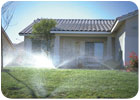
Point-of-use devices can be plumbed in or faucet-attached.
Implementing a point-of-use (POU) or point-of-entry (POE) treatment strategy may be substantially less expensive than building, expanding or upgrading a central treatment plant because only a portion of water used in a building is treated to a higher level. It is important to understand both capital and operating and maintenance (O&M) costs associated with a device and other factors that impact costs.
When it is determined that a POU/POE treatment device can adequately address site-specific factors, and can comply with all state, local and federal regulations, a cost estimate should be developed. The goal of the cost estimate is to determine if the POU or POE treatment strategy selected for consideration would be economically feasible in a full-scale application when compared to other alternatives.
When developing an estimate, capital costs and O&M costs need to be determined. However, O&M costs associated with inspection, maintenance and monitoring POU or POE devices may be difficult to determine. Keep in mind that higher maintenance and monitoring costs may offset initial reduction in capital expenditures. In other words, the lowest cost may not necessarily be the best option for a system if higher O&M costs are going to be incurred.

Not all water needs to be treated to the highest standards.
Capital costs are affected by the following:
- Purchase costs – These costs can be influenced by device configuration, ANSI/NSF certification, device production rate, volume discount rates, post-device disinfection, alarms, meters and life the of the unit.
- Installation costs – Installation costs can vary significantly depending on the type of POU/POE unit, complexity of the unit, and size of the unit. Some devices require that a waste discharge line be installed; that could affect costs. Also, POU devices installed under a sink may require additional carpentry work for the POU device to fit under the sink.
- Number of taps being treated – If the customer decides to have POU devices installed at multiple taps within each household (such as at the kitchen and bathroom sinks), then the capital costs will increase, as more devices will need to be purchased.
- Permitting costs – Costs may be incurred for permitting of the POU/POE treatment strategy. For instance, some states require an engineering review and approval of any treatment installed at a public water system, and a fee usually is assessed by the state for this review.
- Pilot testing – In some instances, a water system may elect or may be required to conduct a pilot study to verify the selected POU or POE device will adequately treat the water. A professional usually is needed to assist the system with establishing the pilot test protocol, overseeing the pilot test, taking samples to verify level of treatment (resulting in laboratory analysis costs), and developing a report that presents the pilot test results.
- Legal costs – The system may need to obtain legal assistance to develop access agreements that will grant system personnel, or an individual under contract with the system, legal access to all POU or POE devices for maintenance and monitoring.
-
Public education – A city water system should invest in public education prior to installation of a POU or POE device. The system should educate its customers about POU/POE devices, how the devices work, required maintenance and monitoring, and the need for someone to have access to the device to perform required maintenance and monitoring.

A point-of-entry installation.
O&M costs will be affected by the following three factors:
- Maintenance frequency – The maintenance frequency will depend on site-specific conditions. Maintenance will include replacement components (such as replacement cartridges) and labor. A device that requires frequent maintenance visits may result in substantial O&M costs. The calculation of maintenance costs also should take into account unanticipated service calls to address leaks and other repairs.
- Monitoring frequency – Monitoring costs consist of laboratory analyses costs and labor. Labor will include making the arrangements for the monitoring visit and taking the water sample. A device that requires frequent monitoring may result in substantial O&M costs.
- Residual disposal – In some instances, the system may have to develop a new waste disposal system to accept the waste from devices that regenerate automatically. The system probably will experience ongoing costs for the O&M of the waste disposal system.
ND
This article is excerpted from “Point-of-Use or Point-of-Entry Treatment Options for Small Drinking Water Systems,” prepared for the United States Environmental Protection Agency by The Cadmus Group Inc.
Report Abusive Comment